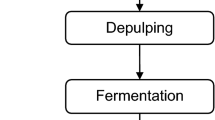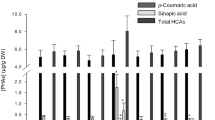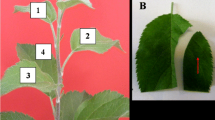Abstract
We examined the role of phenolic compounds, and the enzymes peroxidase and polyphenol oxidase, in the expression of resistance of coffee plants to Leucoptera coffeella (Lepidoptera: Lyonetiidae). The concentrations of total soluble phenols and chlorogenic acid (5-caffeoylquinic acid), and the activities of the oxidative enzymes peroxidase (POD) and polyphenol oxidase (PPO), were estimated in leaves of Coffea arabica, C. racemosa, and progenies of crosses between these species, which have different levels of resistance, before and after attack by this insect. The results indicate that phenols do not play a central role in resistance to the coffee leaf miner. Differences were detected between the parental species in terms of total soluble phenol concentrations and activities of the oxidative enzymes. However, resistant and susceptible hybrid plants did not differ in any of these characteristics. Significant induction of chlorogenic acid and PPO was only found in C. racemosa, the parental donator of the resistance genes against L. coffeella. High-performance liquid chromatography (HPLC) analysis also showed qualitative similarity between hybrids and the susceptible C. arabica. These results suggest that the phenolic content and activities of POD and PPO in response to the attack by the leaf miner may not be a strong evidence of their participation in direct defensive mechanisms.

Similar content being viewed by others
References
Appel, H. M. 1993. Phenolics in ecological interactions: The importance of oxidation. J. Chem. Ecol. 19:1521–1552.
Bi, J. L. and Felton, G. W. 1995. Foliar oxidative stress and insect herbivory: Primary compounds, secondary metabolites, and reactive oxygen species as components of induced resistance. J. Chem. Ecol. 21:1511–1527.
Bi, J. L., Murphy, J. B., and Felton, G. W. 1997. Antinutritive and oxidative components as mechanisms of induced resistance in cotton to Helicoverpa zea. J. Chem. Ecol. 23:97–117.
Bradford, M. N. 1976. A rapid and sensitive method for the quantitation of microgram quantities of protein utilizing the principle of protein–dye binding. Anal. Biochem. 72:248–254.
Clifford, M. N. 1985. Chlorogenic acids, pp.153–202, in R. J. Clarke and R. Macrae (eds.). Coffee. Vol. 1. Chemistry. Elsevier, London.
Clifford, M. N., Williams, T., and Bridson, D. 1989. Chlorogenic acids and caffeine as possible taxonomic criteria in Coffea and Psilanthus. Phytochemistry 28:829–838.
Clifford, M. N., Johnston, K. L., Knight, S., and Kuhnert, N. 2003. Hierarchical scheme for LC-MSn identification of chlorogenic acids. J. Agric. Food Chem. 51:2900–2911.
Constabel, C. P. and Ryan, C. A. 1998. A survey of wound- and methyl jasmonate-induced leaf polyphenol oxidase in crop plants. Phytochemistry 47:507–511.
Constabel, C. P., Yip, L., Patton, J. J., and Christopher, M. E. 2000. Polyphenol oxidase from hybrid poplar. Cloning and expression in response to wounding and herbivory. Plant Physiol. 124:285–295.
Deddeca, D. M. 1957. Anatomia e desenvolvimento ontogenético de Coffea arabica L. var. typica Cramer. Bragantia 16:315–366.
Duffey, S. S. and Stout, M. J. 1996. Antinutritive and toxic components of plant defense against insects. Arch. Insect Biochem. Physiol. 32:3–37.
Felton, G. W., Donato, K., Del Vecchio, R. J., and Duffey, S. S. 1989. Activation of plant polyphenol oxidases by insect feeding damage reduces nutritive quality of foliage for noctuid herbivores. J. Chem. Ecol. 15:2667–2694.
Felton, G. W., Workman, J., and Duffey, S. S. 1992a. Avoidance of antinutritive plant defense: Role of midgut pH in Colorado potato beetle. J. Chem. Ecol. 18:571–583.
Felton, G. W., Donato, K. K., Broadway, R. M., and Duffey, S. S. 1992b. Impact of oxidized plant phenolics on the nutritional quality of dietary protein to a noctuid herbivore, Spodoptera exigua. J. Insect Physiol. 38:277–285.
Felton, G. W., Summers, C. B., and Mueller, A. J. 1994. Oxidative responses in soybean foliage to herbivory by bean leaf beetle and 3-cornered alfalfa hopper. J. Chem. Ecol. 20:639–650.
Goldberg, R., Le, T., and Catesson, A. M. 1985. Localization and properties of cell wall enzyme activities related to the final stages of lignin biosynthesis. J. Exp. Bot. 36:503–510.
Guerreiro-Filho, O. Identification de génes de résistance á Perileucoptera coffeella em vue de l'amélioration de Coffea arabica: Potentiel d'espéces diploïdes du genre Coffea; génes de Bacillus thuringiensis. 1994. 173f. Thése de Doctorat. ENSAM-Montpellier.
Guerreiro-Filho, O. and Mazzafera, P. 2000. Caffeine does not protect coffee against the leaf miner, Perileucoptera coffeella. J. Chem. Ecol. 26:1447–1464.
Guerreiro-Filho, O., Silvarolla, M. B., and Eskes, A. B. 1999. Expression and mode of inheritance of resistance to leaf miner. Euphytica 105:7–15.
Hartley, S. E. and Firn, R. D. 1989. Phenolic biosynthesis, leaf damage, and insect herbivory in birch (Betula pendula). J. Chem. Ecol. 15:275–283.
Horwath, K. L. and Stamp, N. E. 1993. Use of dietary rutin to study molt initiation in Manduca sexta larvae. J. Insect Physiol. 39:987–1000.
Katiyar, K. P. and Ferrer, F. 1968. Technique biology and sterilization of the coffee leaf miner, Leucoptera coffeella Guér (Lepidoptera: Lyonetiidae), p.165–175. International Atomic Energy Agency, Vienna.
Mazzafera, P. 1999. Chemical composition of defective coffee beans. Food Chem. 64:547–554.
Mazzafera, P. and Robinson, S. P. 2000. Characterization of polyphenol oxidase in coffee. Phytochemistry 55:285–296.
Mazzafera, P., Gonçalves, W., and Fernandes, J. A. R. 1989. Fenóis, peroxidase e polifenoloxidase na resistência do cafeeiro a Meloidogyne incognita. Bragantia 48:131–142.
Melo, G. A., Shimizu, M. M., and Mazzafera, P. 2006. Polyphenoloxidase activity in coffee leaves and its role in resistance against the coffee leaf miner and coffee leaf rust. Phytochemistry 67:277–285.
Parra, J. R. P. 1985. Biologia comparada de Perileucoptera coffeella (Guérin-Méneville, 1842) (Lepidoptera:Lyonetiidae) visando ao seu zoneamento ecológico no Estado de São Paulo. Rev. Braz. Entomol. 29:45–76.
Paulini, A. E., Matiello, J. B., and Paulino, A. J. 1976. Oxicloreto de Cobre Como Fator de Aumento da População do Bicho-Mineiro do Café (Perileucoptera coffeella Guérin-Mén., 1842), pp. 48–49. in: Congresso Brasileiro de Pesquisas Cafeeiras, 4, 1976, Caxambu. Resumos..., Rio de Janeiro: IBC–CERCA.
Pereira, A. B. 2000. Enraizamento de estacas em Coffea arabica L. Thesis, Universidade Federal de Lavras.
Ramiro, D. A, Guerreiro-Filho, O., Queiroz-Voltan, R. B., and Matthiesen, S. C. 2004. Caracterização anatômica de folhas de cafeeiros resistentes e suscetíveis ao bicho-mineiro. Bragantia. 63:363–372.
Stamp, N. E. 1990. Growth versus molting time of caterpillars as a function of temperature, nutrient concentration and phenolic rutin. Oecologia 82:107–113.
Stamp, N. E. and Yang, Y. 1996. Response of insect herbivores to multiple allelochemicals under different thermal regimes. Ecology 77:1088–1102.
Stout, M. J., Workman, J., and Duffey, S. S. 1994. Differential induction of tomato foliar proteins by arthropod herbivores. J. Chem. Ecol. 20:2575–2594.
Stout, M. J., Workman, K. V., Bostock, R. M., and Duffey, S. S. 1998. Specificity of induced resistance in the tomato, Lycopersicon esculentum. Oecologia 113:74–81.
Swain, T. and Hillis, W. E. 1959. The phenolic constituents of Prunus domestica. I. The quantitative analysis of phenolic constituents. J. Sci. Food Agric. 10:63–68.
Thomaziello, R. A., Toledo-Filho, J. A., and Oliveira, E. G. 1979. Guia para identificação das deficiências minerais, toxidez, distúrbios fisiológicos, pragas e doenças do cafeeiro. Campinas: Coordenadoria de Assistência Técnica Integral. 81p.
Zonta, E. P. and Machado, A. A. 1992. SANEST - Sistema de Análise Estatística para Microcomputadores. Piracicaba: SEI, 1992 (software).
Acknowledgments
This study was partially financed by the Consórcio Brasileiro de Pesquisa e Desenvolvimento do Café. D.A.R. and P.M. thank CAPES and CNPq-Brasil for research fellowships. The authors thank Geraldo A. Melo for technical assistance with enzymes and HPLC analyses.
Author information
Authors and Affiliations
Corresponding author
Rights and permissions
About this article
Cite this article
Ramiro, D.A., Guerreiro-Filho, O. & Mazzafera, P. Phenol Contents, Oxidase Activities, and the Resistance of Coffee to the Leaf Miner Leucoptera coffeella . J Chem Ecol 32, 1977–1988 (2006). https://doi.org/10.1007/s10886-006-9122-z
Received:
Revised:
Accepted:
Published:
Issue Date:
DOI: https://doi.org/10.1007/s10886-006-9122-z




